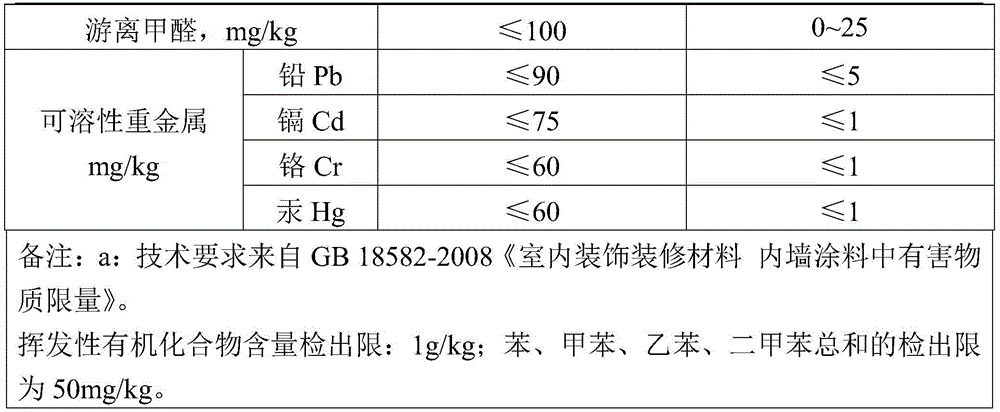Environment-friendly interior wall putty powder and putty paste and preparation method thereof
An interior wall putty powder, an environmentally friendly technology, applied in the field of architectural decorative gel materials, environmentally friendly putty powder and putty paste, can solve problems such as complex formulas and process procedures, easy hollowing, complex processes, etc., and achieve excellent hydrophobicity Excellent performance and water resistance, small change in drying shrinkage size, and simple preparation method
- Summary
- Abstract
- Description
- Claims
- Application Information
AI Technical Summary
Problems solved by technology
Method used
Image
Examples
Embodiment 1
[0033]1. Weigh the basic raw materials and auxiliary raw materials respectively according to the set raw material ratio, and the basic raw materials are: 50 parts of talc powder, 25 parts of heavy calcium carbonate, 10 parts of calcium-based bentonite, carboxymethyl fiber 1 part of plain sodium, 0.5 parts of hydroxyethyl cellulose, 4.9 parts of polyacrylamide; auxiliary raw materials: 8 parts of α-pregelatinized starch, 0.6 parts of carboxymethyl cellulose.
[0034] 2. Take about 1 / 3 of the talcum powder weighed according to a certain proportion and put it in the mixing and stirring device, then add auxiliary raw materials in order from small to large according to the weight percentage, pre-mix evenly and then according to the weight percentage from small to large Add the base stock followed by the remaining talc, pre-stirring to combine.
[0035] 3. Directly stir the uniformly mixed material in step 2 at high speed for 10-15 minutes, discharge it, and send it to the finished ...
Embodiment 2
[0038] 1. Weigh the basic raw materials and auxiliary raw materials respectively according to the set raw material ratio, and the basic raw materials are: 60 parts of talcum powder, 18 parts of heavy calcium carbonate, 6 parts of calcium-based bentonite, carboxymethyl fiber 0.6 parts of plain sodium, 1 part of hydroxyethyl cellulose, 1.5 parts of polyacrylamide; auxiliary raw materials are: 12 parts of construction gypsum powder, 0.5 parts by weight of sodium dodecylbenzenesulfonate, carboxymethyl cellulose 0.4 parts.
[0039] 2. Take about 1 / 3 of the talcum powder weighed according to a certain proportion and put it in the mixing and stirring device, then add auxiliary raw materials in order from small to large according to the weight percentage, pre-mix evenly and then according to the weight percentage from small to large Add the base stock followed by the remaining talc, pre-stirring to combine.
[0040] 3. Stir the uniformly mixed material in step 2 at high speed for 10-...
Embodiment 3
[0043] 1. Weigh the basic raw materials and auxiliary raw materials respectively according to the set raw material ratio, and the basic raw materials are: 72 parts of talcum powder, 10 parts of heavy calcium carbonate, 5 parts of calcium-based bentonite, carboxymethyl fiber 0.6 parts of plain sodium, 0.3 parts of hydroxyethyl cellulose, and 1.3 parts of polyacrylamide; auxiliary raw materials: 10 parts of construction gypsum powder, 0.3 parts of α-pregelatinized starch, and 0.5 parts of hydroxypropyl methylcellulose.
[0044] 2. The processing steps 2-4 are the same as those in Embodiment 2.
PUM
| Property | Measurement | Unit |
|---|---|---|
| particle size | aaaaa | aaaaa |
| whiteness | aaaaa | aaaaa |
| particle size | aaaaa | aaaaa |
Abstract
Description
Claims
Application Information
 Login to View More
Login to View More - R&D
- Intellectual Property
- Life Sciences
- Materials
- Tech Scout
- Unparalleled Data Quality
- Higher Quality Content
- 60% Fewer Hallucinations
Browse by: Latest US Patents, China's latest patents, Technical Efficacy Thesaurus, Application Domain, Technology Topic, Popular Technical Reports.
© 2025 PatSnap. All rights reserved.Legal|Privacy policy|Modern Slavery Act Transparency Statement|Sitemap|About US| Contact US: help@patsnap.com



